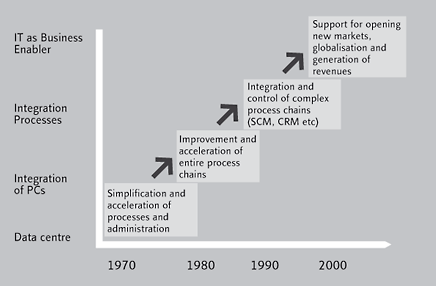 |
Strategic IT Management

Commonly, IT managers are caught in an area of conflict with the burden of high expectations:
- Improved quality accompanied by equal budget
-
Equal quality accompanied by a shrinking budget
Staff cuts (Employee reduction) have reached a dimension where further reduction in staff cost (salary) without loss of quality is virtually impossible.
Hence, the challenging priorities for the IT management are:
- IT sourcing
- Cutting cost without cutting staff (reducing employees)
- Optimisation of ERP / IT infrastructure and architecture
-
More flexible IT architectures
- IT governance (organisation and planning of IT projects)
-
Portfolio management / priorisation of projects
However, these issues require a longer time schedule than the realisation of performance improvement by staff cuts (reducing employees). For this reason, the management of this agenda will become even more important.

The following aspects should be considered within this managements' agenda:
- As 95% of all IT budgets are used to sustain daily business processes, the IT budget commonly counts to the overhead cost. These are constantly monitored within the scope of cost reduction.
-
Only 5% of the IT budgets are available for development of new solutions which can be used to secure the competitive advantage of a business.
-
The main goal of IT is cost reduction and quality improvement for internal processes. Decisions on investments, however, are taken not only on the above but are also oriented on the value potential of the IT system itself.
- To accomplish this, IT must not be considered as overhead cost alone.
-
Furthermore, IT has to become an active player in business development.
-
Only if IT strategy becomes an integral part of the corporate strategy, IT will be able to contribute significantly to competitive advantages.
-
Integrated leadership and steering instruments are a prerequisite for success.
|
 |













